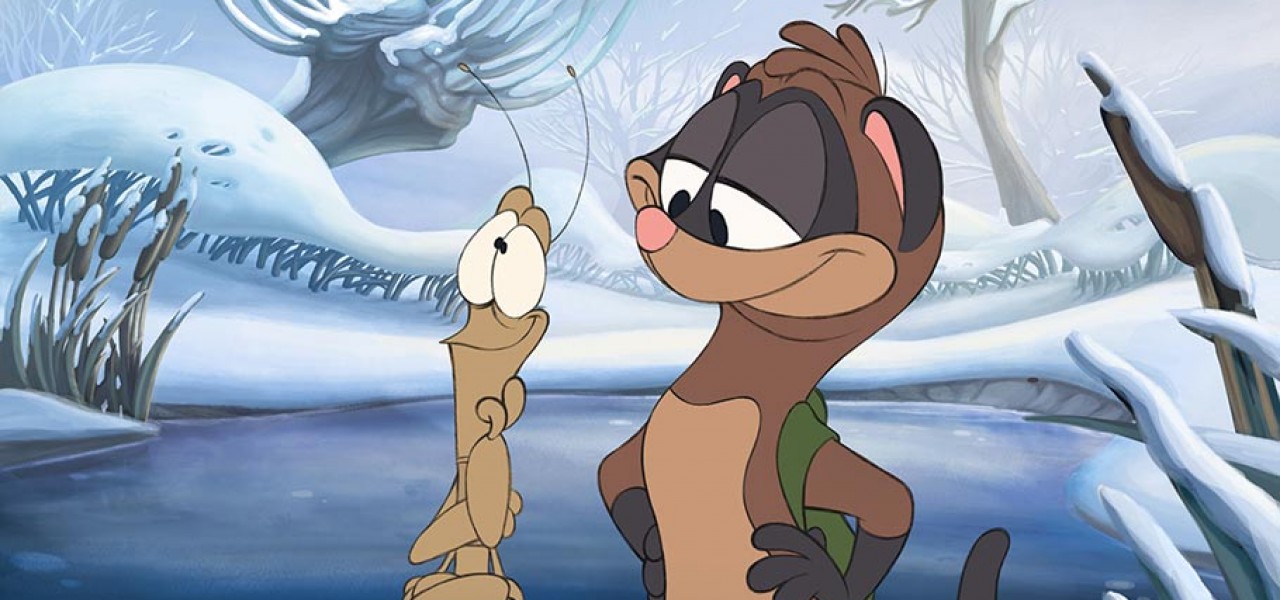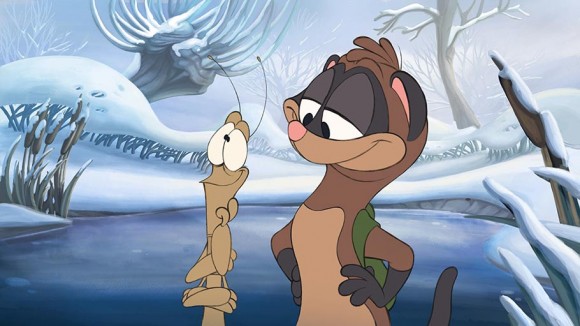

Interview: Directors Albert ‘t Hooft and Paco Vink on ‘Trippel Trappel’

The hand-drawn animated feature film Trippel Trappel (Triple Trouble) finished its Dutch and Belgian theatrical run last December. The international community may not have noticed it, but for a Dutch person like me the release was long-awaited. In the past few years Trippel Trappel had been one of the headliners in the race to be Holland’s first animated feature since Als Je Begrijpt Wat Ik Bedoel? [The Dragon That Wasn’t (Or Was He?), 1983]. Even though it was beaten to theaters by three other homegrown releases, the movie’s completion is a milestone for Dutch animation nonetheless.
The 67-minute family film is based on Sinterklaas, a Dutch tradition that’s celebrated annually on the 5th of December. Similar to Santa Claus, Sinterklaas is an old guy who gives kids presents, assisted by his many helpers (the Zwarte Pieten). Trippel Trappel tells the story from the pets’ perspective: a playful ferret, a sweet canary bird, and a know-it-all stick insect head out to ask Sinterklaas for presents. Through the journey ferret Fred will learn what’s most important in life—toys or friends.
Last December, Cartoon Brew met with the film’s directors Albert ‘t Hooft and Paco Vink (owners of Anikey Studios in The Hague, Netherlands) to discuss the challenges of directing a low-budget theatrical feature in a small animation market like the Netherlands.

Cartoon Brew: Together with producer il Luster, your studio Anikey took on a big challenge. How did you work towards your first feature film?
Albert ‘t Hooft: Ever since [we finished] our studies, our dream has been to make an animated feature. But when we graduated back in 2005, there weren’t many animation studios here in the Netherlands. So on Valentine’s Day 2007 we decided to start our own, in the hopes of realizing a feature-length project sometime in the future. An opportunity came earlier than expected when the producers at il Luster approached us with the concept for Trippel Trappel in 2008.
Paco Vink: At first we were a bit apprehensive about it, but it was a unique opportunity, and we just had to go for it. To improve our storytelling skills and build a team around us, we created with il Luster two 10-minute shorts and a 25-minute film called Paultje en de Draak (Paul and the Dragon, 2008). I think Paultje en de Draak gave us the confidence to say “yes” to the feature. We thought, just triple that 25 minutes and you’ve reached feature length, right?
Cartoon Brew: Looking back now, were you as prepared as you thought you were?
Albert ‘t Hooft & Paco Vink: : No.
Paco Vink: There’s so much stuff to think about. You get such a load of questions thrown at you. Especially in the beginning it’s overwhelming. I don’t think you truly can prepare for it though, and perhaps our naive positivity has been a good thing. Without it, we might have never started at all.
Albert ‘t Hooft: That naivety is definitely gone now [laughs]. It was a stressful process. Production management was fairly improvised; while the animation was in production, storyboard and layout revisions were still being made. Changes in one department would set off a chain reaction in the next departments. Also, Paco and I had way too much on our plate. We directed, supervised layouts and backgrounds, did storyboards, edits, character designs, and even checked the coloring ourselves. The official budget of the film was around €1.7M (approximately US$1.9 million), but I don’t want to be too proud of that since it isn’t realistic. The last six months we practically worked for free because there was more to be done than we anticipated. The trick is to hold onto that enthusiasm of the beginning, keep the final goal in mind, and be happy with the small successes.

Cartoon Brew: il Luster’s Michiel Snijders and Arnoud Rijken, the film’s producers and writers, came up with the concept and asked you to direct the film. What made you say “yes”?
Paco Vink: Sinterklaas makes a great theme for animation. The film has this huge steamboat, lots of presents, magic, all things that inspire the imagination. Plus, the film’s concept is about talking animals—perfect animation material, as every animator knows.
Albert ‘t Hooft: Back then there were very few movies about Sinterklaas, so we thought it would be a good niche. Obviously time got ahead of us; there were three [live-action] Sinterklaas movies in Dutch cinemas this year. We never worried much about it though. We knew ours was going to be way more awesome than the others [laughs].
Cartoon Brew: While Trippel Trappel is built around a typically Dutch tradition, the aim is to release it internationally too. Did you take international viewers into account while writing and directing the film?
Paco Vink: I can imagine some specific parts might [confuse] international viewers not familiar with the tradition of Sinterklaas. But Sinterklaas and his helpers appear only briefly, and everyone understands the basic story of the pets’ quest for presents. Our aim was to tell a universal story and I think we succeeded in that. Actually, I don’t look at Trippel Trappel as being a “Sinterklaas movie.” We have been put in that category by the Dutch press. It was a bit annoying that the Dutch media were only interested in talking about the skin color of the Zwarte Pieten (Sinterklaas’s helpers, literally translated to “Black Petes”).
Albert ‘t Hooft: Over the past few years there have been heated discussions about Sinterklaas’s helpers—if it’s racist that they are in blackface. We do think this stereotype is completely outdated, and from the start we planned to detach them from the cliché in our film. According to a group of Dutch Zwarte Pieten-fanatics, that makes us traitors to our country. They think Trippel Trappel should be boycotted. I don’t think it had a big impact on the number of filmgoers, though.

Cartoon Brew: All the animators on the production are Dutch, and only a few of them had experience in features. How did you assemble your crew and how you train them?
Albert ‘t Hooft: We had worked with roughly half of the crew on projects before; the other half was chosen through selection rounds. Some had just graduated, others had already gained some experience in larger projects through shorts and series. The only animators with actual feature film experience were Marcel Tigchelaar (Aunt Hilda, The Illusionist) and Bob Wolkers (The Illusionist, Zarafa, The Congress). They also made the final model sheets for the Trippel Trappel characters.
Paco Vink: We happened to know Marcel because we were classmates in college. After working throughout Europe for several years, he was excited to return to the Netherlands. Marcel is an animation god. He prepared many keys for the animators to inbetween and had one week to teach the other animators. All animators started out as inbetweeners. Eventually most of them would go on to doing keys themselves.
Paco Vink: I feel like graduates nowadays want to be part of a group process more and more. Animators who graduate now see many studios making great things right here in the Netherlands. It gives them a kind of hope that we didn’t have back when we graduated.

Cartoon Brew: What influenced your decision to use a 2D design that emphasizes the sketchiness of hand-drawn lines.
Paco Vink: We have great affection for traditional craftsmanship. Disney’s Jungle Book has always been one of our favorites thanks to the Xerox machine. You can still see the animator’s hand; it makes the characters come to life. Clean-up can kill a line. And with CGI, you spend much more time (which we didn’t have) trying to make it not look cheap. The closer you get to realism, the more can go wrong.
Albert ‘t Hooft: Our studio’s 2D style that shows the sketchiness of the hand-drawn lines fits the story well. It gives the movie a more nostalgic flavor, which works well with a kids’ tradition like Sinterklaas. Having less clean-up to do also made the producer very happy.

Cartoon Brew: With Trippel Trappel you have achieved your long-time goal of realizing a feature-length animated film. What’s next?
Albert ‘t Hooft: We’d like to make another animated feature—it would be a waste to throw away the experience we gained—but not right now. We set the bar very high on a very tight budget. It was just about doable.
Paco Vink: Actually it wasn’t, but we did it anyway.
Albert ‘t Hooft: That’s true. Perhaps that should be our slogan: “It’s not possible. But we’ll do it anyway.”
Paco Vink: We want to hold the crew together, but in order to do that we need continuity in jobs, which is tough. We’ve built a studio from the ground up and now, after the film is done, we shrink again. Packing everything is a sad thing, but it seems to be the European model. Studios come and they go.

